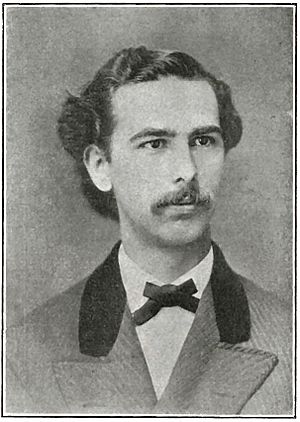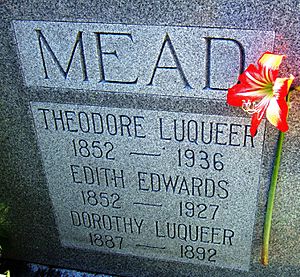Theodore Luqueer Mead facts for kids
Theodore Luqueer Mead (born February 23, 1852 – died May 4, 1936) was an American expert in nature. He studied insects (an entomologist) and plants (a horticulturist). As an entomologist, he found over 20 new kinds of butterflies in North America. He also helped scientists learn about the Florissant Fossil Beds in Colorado. As a horticulturist, he was famous for growing and mixing different types of orchids. He also created new forms of other plants like caladium, bromeliad, crinum, amaryllis, and daylilies. He brought many new warm-weather plants, especially palm trees, to North America.
Contents
Early Life and Education
The Mead family came from England. Theodore Mead was born in Fishkill, New York. His parents were Samuel H. Mead and Mary C. Mead. He went to school in America and Europe. In Europe, he learned French and German. He also studied classic subjects. From a young age, he loved natural sciences. His parents strongly supported this interest.
Butterfly Discoveries
When he was young, Theodore Mead was very interested in butterflies. He learned from William Henry Edwards, a famous butterfly expert. In 1871, when Mead was 19, Edwards suggested he go to Colorado. His job was to find new butterfly species in the Rocky Mountains.
On this trip, Mead collected over 20 butterfly species new to science. Three of these were named after him by Edwards. They are Colias meadii (Mead's Sulphur), Speyeria callippe meadii (Mead's Silverspot), and Cercyonis meadii (Mead's Wood-Nymph). Mead became so good at identifying butterflies that he helped put together all the butterfly discoveries from several expeditions in the American West.
Finding the Florissant Fossil Beds
In September 1871, Mead heard about a strange petrified forest in Florissant, Colorado. He rode there to see it. He quickly understood how important the site was for science. He collected many fossil rocks with insects and leaves inside. He sent these to Samuel Hubbard Scudder, a Harvard University scientist. Scudder's work on these fossils told other scientists about this important place. Today, it is known as the Florissant Fossil Beds National Monument.
University Studies
Mead started at Cornell University in 1874. He studied Civil Engineering and graduated in 1877. That year, he sold his large butterfly collection. He then started focusing on growing plants. After graduating, he continued to do research at Cornell. Natural history quickly became his main passion. He was also active in a student group called Alpha Delta Phi. He helped build their first special house. He was close friends with Louis Agassiz Fuertes, a famous bird artist.
In 1878, Mead and his parents took a six-month trip. They traveled to California and other Western States. They went by ship through Panama. On this trip, they collected many plants and new butterfly species. One butterfly he named Gaeides editha (Edith's Copper). He named it after Edith Edwards, the daughter of his mentor, William Henry Edwards. Theodore and Edith later married in 1882.
Plant Growing in Florida
Mead first visited Florida in 1869. He was collecting butterflies there. He found a very rare butterfly near Enterprise. He thought Florida's climate was perfect for growing warm-weather plants. After he married, he moved to Eustis, Florida. His father had bought him an orange grove and land there. Mead planned to grow citrus and other crops like pineapples. This would give him time for his plant experiments.
In 1886, he bought more land in Oviedo, Florida. This area was closer to Lake Charm and had more fertile land for oranges. He chose a spot next to his wife's aunt, Mary.
At Lake Charm, Mead grew many palm trees from seeds. He also created new types of orchids, bromeliads, crinum, and later, caladium, amaryllis, and daylilies. He became good friends with Henry Nehrling, another plant expert in Florida. They worked together on many plant experiments.
Central Florida's citrus farms did well until the Great Freeze of 1894–95. Many farmers gave up. But Mead realized that underground water, which stays at a constant warm temperature, could protect trees from frost. He used his engineering knowledge to figure out that spraying water over the orange trees could protect the fruit. The water would freeze around the fruit, creating an ice layer that kept the fruit warm inside. He successfully used this method on an acre of oranges. He installed a pump and a watering system. This was the first time this technique was described. It is still used today.
Creating New Plants
Mead wanted to create new types of plants. He aimed for plants that were unique or better than existing ones. He used a careful scientific approach. He also kept very detailed records. He did not seek fame for his work. Henry Nehrling believed Mead was an even better plant creator than Luther Burbank, another famous plant breeder.
Orchids
Back then, growing orchids from seeds was very difficult. This made it hard to grow orchids as a business. It also slowed down Mead's efforts to create new types. Sometimes, he had to wait 10 years or more for a new orchid to bloom. One even took 17 years! But Mead was patient. He used scientific methods and kept careful notes. His plant notebook, kept at the University of Central Florida, lists thousands of plant crosses. He also took photos of many of his new creations.
Mead often wrote for The Orchid Review, a journal from the Royal Horticultural Society. In 1904, he reported on two new orchid types. They were named Cattleya Meadii and Cattleya Oviedo. A Singapore stamp from 1991 even shows Cattleya Meadii.
Mead's biggest help to orchid growing came after more than 25 years of work. A scientist named Lewis Knudson from Cornell University asked Mead for advice. Knudson was trying to grow orchid seeds without special fungi. Mead had realized that seeds grew better in a clean, temperature-controlled place. Knudson's big discovery was using a special jelly (agar) with nutrients to grow orchid seeds reliably. Many believe Knudson would not have succeeded without Mead's help and seeds. Improved versions of Knudson's method are still used today. This discovery helped the orchid industry grow into what it is now.
Bromeliads
In the 1920s, Mead was the first American to create new types of bromeliads. He introduced many new kinds of these plants. He sent his new bromeliads to the Brooklyn Botanic Garden and other growers. He exchanged seeds and plants with E.O. Orpet for many years. Mead introduced Billbergia xmeadii to California. This plant became very popular there. Mead also created the first ever intergeneric bromeliad cross. This means he crossed two different groups (genera) of bromeliads. He crossed cryptanthus beuckeri with billbergia nutans to create xCryptbergia Mead.
Crinum
Mead loved bulbous plants and their beautiful flowers. Around 1890, he got a large collection of about 80 different crinum species from India. He started mixing them to create new types. He created Crinum Kircape around 1894. This was a mix of a species from Zanzibar and one from South Africa. He also created Peachblow around 1900. This plant had tall stems and large, pink-white, sweet-smelling flowers.
Caladium
Both Mead and Henry Nehrling created many new and colorful caladiums. Nehrling even grew them to sell by the thousands. Mead liked to create unusual types. In 1920, he crossed narrow-leaved caladiums with standard ones. This created the "arrow and lance" type caladium. These had interesting narrow leaves and stayed small. They still had the bright colors and patterns of the larger caladiums.
Amaryllis
As his orchid work slowed down, Mead focused more on breeding amaryllis plants. Henry Nehrling helped him a lot. Nehrling had a great collection and let Mead use pollen for his experiments. Mead created nearly white amaryllis with a thin color line around each petal. His red and white striped 'Mead-strain' amaryllis became very popular in American southern gardens in the 1940s and 1950s.
The American Amaryllis Society's yearbook for 1935 was dedicated to Mead. This honored his early work with hybrid amaryllis plants. In 1937, the International Bulb Society gave Mead The Herbert Medal. This award recognized his help in learning more about bulbous plants.
Daylilies
Mead was one of the first people to create new types of daylilies. He made many crosses in the 1920s and 1930s. However, only one, named "Chrome Orange" in 1933, was special enough for him to sell. He thought it had an outstanding color.
Personal Life
Theodore Mead married Edith Katharine Antill Edwards in 1882. They had one child, Dorothy Luqueer Mead. Sadly, Dorothy died from scarlet fever at age 4 in 1892.
Theodore Mead passed away on May 4, 1936. He is buried in Greenwood cemetery in Orlando, Florida.
Legacy
The Mead Botanical Garden, which opened in Winter Park, Florida in 1940, is named in his honor.
A hybrid cultivar of the genus Billbergia, called Billbergia 'Theodore L. Mead', was named after him. This honored his work in creating new types of bromeliads.



